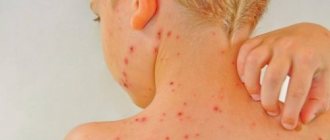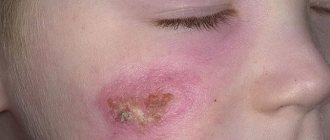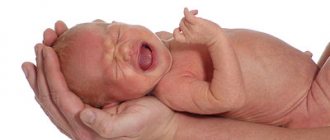Dog attack on a child
When a child is bitten by a dog, parents need to be able to provide first aid correctly without giving in to panic, since the outcome of further treatment depends on this. A dog attack always harms a child’s health, and a bite or even a slight scratch from a rabid animal can most likely lead to the death of the victim.
Basic information
It's no secret that dog bites are very dangerous. Therefore, questions about what to do if a child is bitten by a dog, what to do in this case, are quite relevant.
Experts say that an attack by a healthy animal requires mandatory wound treatment. As for a rabid dog, such bites can be deadly. In this regard, such injuries should be responded to as quickly as possible. Moreover, even a light scratch received from a sick dog can lead to disastrous consequences.
How to avoid being bitten
No matter how trivial it may sound, safe behavior is the basis for preventing dog bites. Animals are not initially opposed to humans; their genes contain a friendly program of mutually beneficial coexistence. Therefore, children need to be explained as early as possible the rules of behavior with dogs, their own and others’, and also necessarily with stray or obviously homeless ones.
- Refrain from approaching a dog with its puppies nearby. A mother dog may interpret any human gesture as threatening and will instinctively attack.
- Do not wake a sleeping dog unless necessary. A resting animal that is suddenly disturbed may show dissatisfaction and attempt to drive away the offender.
- Do not disturb the dog while eating. She may perceive the approach of a person as an encroachment on her food, and if there is not enough food, the dog’s aggression will be inevitable.
- Respect the dog's personal space. She should also have a place of solitude or shelter to take a break from the annoying attention of children.
- Do not approach or even try to pet an unfamiliar dog.
- Communicate with someone else's dog only with the permission of its owner and in his presence.
- Do not leave children alone with the dog.
Parents are required to instill in their children responsibility towards pets and thoughtful behavior when interacting with dogs.
Dog bites can be dangerous for a child, and in a mild form they cannot be avoided. It is important that such experience, independently obtained in this life, becomes the basis for competent behavior and does not give rise to fears, speculation and anxiety due to possible encounters with an animal in the future. Dogs are, first of all, human friends, and their character, level of education and degree of socialization depend on the owner, his environment and conditions of detention.
my three-year-old was unexpectedly bitten by a family dog (we were visiting friends). She either pulled the child’s paw or upset her in some other way; the result was small scratches—like bite marks. The dog is a HOME, not a street dog.
Should I do something about this (some kind of injections?), besides smearing the scratches?
Find out if you have had a rabies vaccination in the past 2 years
And next. keep an eye on the kids
Share with friends
Celebrities trending
about the project
All rights to materials posted on the site are protected by copyright and related rights legislation and cannot be reproduced or used in any way without the written permission of the copyright holder and placing an active link to the main page of the Eva.Ru portal (www.eva.ru) next to with the materials used. The editors are not responsible for the content of advertising materials. Certificate of registration of mass media El No. FS77-36354 dated May 22, 2009 v.3.4.261 © Eva.ru 2002-2019
We are in social networks
Memo to parents
A child was bitten by a dog - what to do and what to do? This is the first question that arises in the minds of most parents whose children have been harmed by an animal. Very often, dog attacks on a child result in serious injuries and severe lacerations. That is why parents should be very careful about the safety of young children. However, it is not advisable to let them get too close to the dogs. After all, many children themselves behave incorrectly with animals - they scare them, tease them, pull their tails, etc. As a result of this behavior, they are capable of provoking aggression even in a completely peaceful dog.
A dog bit a child - what to do? Unfortunately, few parents know the answer to this question. Therefore, most of these attacks cause serious complications. To prevent their occurrence, we will tell you what measures should be taken in this case.
Legal actions
If the baby was attacked not by a yard dog, but by a dog who went for a walk with the owner, but there was no leash and no muzzle, you have the right to demand compensation for moral and physical damage.
You will need to follow the following procedure:
- Immediately contact a medical institution, where the child will be provided with qualified assistance and the fact of the attack will be recorded.
- With the completed certificate and application, you go to the police, where they open a case. Based on the documents provided, the owner of the dog will be charged money for the damage caused.
- They may also be sent for examination. This is necessary to establish the penalty, as well as the amount of the fine to be paid.
What to do if a dog bites a child
If a dog causes injury to someone's minor child, the owner needs to be prepared to answer for it. Parents will probably ask for compensation.
However, some parents insist on going to court, especially if the owner refuses to compromise. In this case, the question arises: “If a dog bites you, what should you do, where should you go, and is it legal to demand compensation?” According to Russian laws, a person does have the right to file an application in court. The child's parents can request compensation, which is calculated based on the age of the victim, the severity of the bite, the cost of treatment and other factors. In this case, the animal owner will be forced to pay a significant amount to the family.
What documents do you need to have after a dog bites a person?
To prove that a dog actually bit a person, you must:
- Photocopy the statement made to the police.
- Get a certificate from the emergency room.
- Make a copy of the patient's card with a record of the bite and prescribed treatment.
- Keep all receipts issued when purchasing medications to treat your injury.
Note! It would also be a good idea to print out a photo of the bite, the scene of the incident, the torn clothes and the dog involved in the incident.
Statement to the police
In case of harm to health, you should file a statement with the police. Employees must take an explanation from the owner of the animal and eyewitnesses of the incident. Additionally, a forensic medical examination may be ordered to determine the severity of the injuries resulting from the bites.
If the owner did not have criminal intent, and the animal’s attack was an accident, then the initiation of a criminal case will be refused. However, the case materials collected by the police in the process of establishing the circumstances of the incident will confirm the fact of the dog attack for further legal proceedings.
Determining the amount of damage
Material damage received by the victim is assessed on the basis of checks and receipts confirming the actual costs of treatment and rehabilitation. The victim of the attack may be able to recover from the dog owner the income he did not receive while undergoing treatment.
For example, if the victim, while undergoing treatment, cannot work, then the amount of salary that he did not receive during this period can be recovered from the dog’s owner.
Compensation for moral damage is determined taking into account the provisions of Art. 151 Civil Code of the Russian Federation. Its size depends on the degree of moral and physical suffering of the victim, as well as on the degree of guilt of the offender.
Going to the hospital
Even before going to the hospital, you should ask the animal owner for information about the availability of vaccinations. The dog must be vaccinated against rabies. Otherwise, the victim will require an additional course of treatment for this disease.
When contacting a medical facility, it is necessary not only to receive medical assistance, but also to record all injuries from bites. The doctor must issue a certificate indicating the extent and area of the bites.
In addition, you need to obtain a list of necessary medications that will be required for treatment. This list must be certified by the doctor’s signature and seal.
Responsibility of the dog owner
If a child is bitten by a dog, the owner of the animal will be responsible for the damage caused. At the same time, current legislation presupposes, along with various types of punishment, the obligation to compensate for physical, material and moral harm.
Thus, the Criminal Code of the Russian Federation provides for several types of criminal liability:
- The disposition of Part 1 of Article 115 of the Criminal Code states that for intentionally causing minor harm to a child, resulting in a short-term health disorder, the owner of the dog will be punished with a fine. Its size is determined by an amount of up to 40 thousand rubles, or the amount of payment for the last three months, or the amount of other income for the same period. Compulsory labor up to 480 hours, correctional labor up to 1 year, arrest for up to 4 months are possible;
- According to Part 1 of Article 112 of the Criminal Code, the owner of the dog will be held liable if, as a result of bites, a child suffers moderate harm. This is provided that the harm was not dangerous to the child’s life and did not entail consequences characteristic of grave harm. The court will accept one of the sanctions: restriction of freedom for up to three years, forced labor for the same period, arrest for up to 6 months, imprisonment for up to 3 years;
- If the actions of the dog owner are qualified as causing harm to the health of a child through negligence, then, according to the sanction of Part 1 of Article 118 of the Criminal Code, he will face a fine of 80 thousand rubles or in the amount of salary or other income for six months, or compulsory labor lasting 480 hours, or correctional labor for 2 years, or restriction of freedom for up to 3 years, or arrest for 6 months;
- More serious consequences are punishable under Part 1 of Article 111 of the Criminal Code. Thus, serious harm to health, dangerous to the life of a child, or which resulted in loss of vision, speech, hearing, or some organ of the child, loss of organ functions resulting in mental disorder, permanent disfigurement of the face, the owner of the dog will be sent to prison for a term of up to 8 years.
Each case of a child being bitten by a dog must be registered at the local police station, after which a thorough check must be carried out. During it, explanations are taken from the child’s parents, the dog’s owner, and eyewitnesses of the animal’s aggressive behavior.
A law enforcement official is obliged to inspect the scene of the incident, record all traces in photographs or videos, and seize documents and objects that can be recognized as material evidence.
If there are sufficient grounds, a criminal case is initiated, and during its course, appropriate examinations are appointed. After the investigation is completed, the case is sent to court.
Protocols on such offenses are drawn up by the police. They are guided by regional laws, according to which dog owners are held accountable for violating the rules for keeping animals.
So:
- Parts 7 - 9 of Article 5.1 of the Moscow City Code on Administrative Offenses for an attack by a domestic animal due to the negligence of its owner, resulting in harm to human health, if the owner of the dog is an individual, a fine of 4 to 10 thousand rubles is imposed on him. If the owner is a legal entity, then the fine ranges from 10 to 16 thousand rubles;
- If a dog is deliberately set on people or animals, an administrative fine of 2 to 5 thousand for citizens and from 5 to 10 thousand rubles is imposed. on officials;
- If a dog causes damage to property, then an individual (the owner of the animal) is subject to an administrative fine of 500 rubles. up to 1 thousand rubles. If the dog belongs to a legal entity, it will be subject to a fine of 6 to 10 thousand rubles.
Upon application by the injured party, the Police are obliged to take one of two possible decisions:
- to initiate criminal proceedings;
- refuse to initiate criminal proceedings.
If the initiated case is sent to court, then the possibility of compensation for the damage caused and moral damage is decided through criminal proceedings. If you refuse to initiate a criminal case, recovery of material damage and moral damage will have to be sought through civil proceedings.
How to punish the owner of a bitten dog
If a dog bites a child, parents should take a number of measures to record:
- who owns the dog;
- circumstances of the incident;
- witnesses to the conflict;
- how the dog was walked - with or without a leash, with or without a muzzle;
- where the dog was walked - in designated or not designated areas.
Important! Immediately call an ambulance or visit a medical facility yourself. At the hospital, record the fact of the animal attack, as well as the injuries caused to the child.
Request a certificate from your doctor that includes the following information:
- information about the person who sought medical help;
- last name, first name, patronymic of the doctor who provided first emergency aid;
- what preliminary diagnosis was made and the nature of the physical injuries caused to the child;
- whether they have signs indicating that they were caused by an animal;
- date and time of admission to the hospital:
- day, month, year and time of preparation of the certificate;
- surname, initials and signature of the doctor, certified by a personal seal or the seal of a medical institution
After visiting the hospital, you should contact the Police to report an offense. According to criminal procedural law, an application can be submitted either orally or in writing.
Remember! After checking the facts stated in the parents' statement, the Police, if there are sufficient grounds, initiate a criminal case. A forensic medical examination will be required, based on the results of which the actions of the dog owner will be qualified.
Criminal prosecution allows the child's parents to file a civil claim for compensation for damage caused and funds for moral compensation.
With the help of a lawyer, it will be possible to prepare a reasoned petition for the appointment of a forensic medical examination, a list of questions that should be put to the expert’s permission.
Correctly posed questions will allow the forensic expert to give an opinion on the nature and severity of the injuries received, and the method of their receipt.
ATTENTION! View a completed sample statement to the police about a dog attack on a child:
Administrative responsibility according to local rules
Administrative liability is brought if the owner of the dog is not actually to blame for the incident, did not deliberately poison the dog, and the injured person suffered a psychological shock or received a minor injury.
For the actions of a dog that bit a person, an individual will have to pay 5 thousand rubles, and an official - about 50 thousand rubles. There are also local administrative regulations. For example, owners of Moscow dogs can be fined if the animal is walked in the wrong place, appears on the territory of children's institutions, is not properly registered, or is set on people or other animals.
Criminal liability
The liability of the dog owner may be determined in accordance with the provisions of criminal law. This happens if the owner’s behavior is characterized by a particular social danger or serious consequences occur.
First of all, the victim submits a statement to the police department. The appeal contains a brief description of what happened and a request to punish the guilty person for causing harm to the child’s health. The applicant is not obliged to independently qualify criminal actions; this is the competence of representatives of the law enforcement system. Usually the incident is attributed to one of the following crimes:
- Part 1 Art. 118 of the Criminal Code of the Russian Federation - careless infliction of grievous harm to human health (the animal got out of control due to negligence, due to frivolous behavior);
- Art. 111 and 112 - intentional grievous harm and intentional harm of moderate severity (for example, targeted bullying may fall under these standards);
- Art. 115 - intentional minor injuries.
In practice, careless owners whose irresponsibility has led to criminal consequences are most often prosecuted under Part 1 of Art. 118 CC. A typical example is a man walking with a bulldog near a playground where children were playing. The dog pulled out the leash and attacked the baby. In this case, the guilty person bears one of the penalties specified in the sanction article:
- fine - up to 80,000 rubles or in the amount of six months' salary of the convicted person;
- compulsory work - up to 480 hours;
- correctional labor - up to 2 years;
- restriction of freedom - no more than 3 years;
- arrest - no more than six months.
Important! Preliminary investigation in a criminal case for a crime under Art. 118 of the Criminal Code, is carried out in the form of an inquiry. This is an accelerated and simplified pre-trial procedure.
Light or moderate damage caused without intent is not criminally punishable. For such violations, punishment under the Criminal Code is applied only if purposeful actions are confirmed.
Peaceful settlement
You can settle the issue of compensation for damage caused without going to court. To do this, the owner of the neighbor's dog will have to pay for the treatment of the victim. But they rarely agree to this, since a peaceful settlement is disadvantageous for both sides.
For your information! The dog caused not only physical, but also mental harm. Proving the presence of the latter will be difficult.
A bitten person sometimes makes impossible demands and tries to get more than his due. If there really is damage, then it is better to determine compensation through the courts.
Pre-trial settlement
Disputes worth up to 50 thousand rubles are settled pre-trial.* To do this, the dog owner:
- present photos and videos from the scene of the incident, damaged items, a photograph of the injury;
- copies of documents certifying that paid treatment was provided;
- send a written claim (indicate the type and amount of compensation).
If the dog’s owner has not responded to the complaint, does not answer calls and does not want to meet, then this is one of the grounds for going to court.
Important! The claim and copies of payment receipts are sent by registered mail. The mail notifies the sender of its receipt. Before shipping, an inventory of the contents is compiled.
The dog may bite during play
How to determine the amount of harm
For harm caused to a child as a result of dog bites, its owner is obliged to:
- compensate for damage caused to health and property in accordance with paragraph 1 of Article 1064 of the Civil Code of the Russian Federation;
- compensate for moral damage by virtue of Article 151 of the Civil Code of the Russian Federation.
If, as a result of dog bites, a child suffers injury or other damage to health, which in turn forces employed parents to stay with him in the hospital, care for him and, as a result, lose income due to absenteeism from work, then lost earnings will be recovered from the owner of the dog or other income, as well as all expenses incurred by the child’s parents for the purchase of medicines, additional nutrition, prosthetics, and sanatorium treatment. This comes from paragraph 1 of Article 1085 of the Civil Code of the Russian Federation.
If the property cannot be restored, then its cost must also be compensated by the owner of the animal. However, you should have supporting documents about the real value of the damaged items. The expenses incurred by the parents of the injured child must be documented.
The court makes a decision on the case in accordance with Article 151 of the Civil Code, determining the amount of compensation for causing moral damage, taking into account the severity of the consequences that the child received as a result of dog bites, the intentional or careless actions of the animal owner, his financial condition, as well as other circumstances worthy of attention.
Filing a claim in court
As mentioned above, the victim has the right to complain to the court if the dog owner refuses to compensate for the damage without government intervention. In this case, you must fill out an application.
It is filled out in accordance with the following rules:
- header (to which court the claim was sent, who the plaintiff and defendant are, what address they live at, what is the price of the claim);
- By ;
- description of the events (when the attack occurred, what the dog looked like, severity of the wound);
- fact of contacting a medical center (name of hospital, assistance provided);
- the fact of contacting the defendant;
- grounds for filing a claim (articles of the criminal code referred to by the plaintiff);
- request for compensation.
Important! A copy of it must be attached to the application, as well as documents indicating that the defendant was contacted, received medical care, and other expenses associated with the injury.
So, if a dog bites you, where should you go? First of all, it is necessary to assess the severity of the wound and visit the emergency room, where the victim will receive assistance. If the animal has an owner, the victim has the right to file an application in court and demand compensation.
Statute of limitations
As a general rule, the statute of limitations is three years. For cases of compensation for damage caused to the health of an individual, it is the same. If for some reason, for example, the duration of treatment, the rehabilitation period, the plaintiff did not meet this deadline, the legislator provides the opportunity to restore it.
Thus, if the injured party has the entire package of documents necessary to compensate for the harm caused, the claim can be filed three years after the events occurred. However, such a late application to the court for protection of one’s rights and legitimate interests must be legally justified. Otherwise, the deadline will be missed and you will not be able to file a claim.
State duty
Depending on the value of the claim, the claim will be considered in the district or magistrate court. The amount of the state duty, which must be paid by the plaintiff when filing a lawsuit, is also calculated from the price of the claims. As calculations show, for a property claim you can pay from 400 to 60,000 rubles.
So, at the cost of the claim:
- up to 20,000 rubles, 4% of this amount is paid, but not less than 400 rubles;
- from 20 to 100 thousand - the plaintiff pays 800 rubles plus three percent of the amount that exceeds 20,000 rubles;
- from 100 to 200 thousand – 3,200 rubles. plus 2% of excess of one hundred thousand;
- from 200 thousand to one million – 5,200 rubles. plus 1% of excess of 200 thousand;
- everything over 1 million - 13,200 rubles. plus half a percent of the excess of one million, but not more than 60,000 rubles.
Filing a claim with a judicial authority
Remember! The current civil legislation provides for two possible types of filing a claim in court:
- submit documents to the court office, receiving a mark of its registration in the incoming correspondence journal;
- send the statement of claim by mail with a list of the contents and a receipt.
The second method is usually used when the plaintiff lives or temporarily stays in another locality. The postal receipt will be proof that the application was filed with the court within the limitation period.
Note! After submitting documents to a specific judge, he gets acquainted with them and sets a court date. He formalizes his decision with a ruling on accepting the case for consideration.
From filing a claim to the court making a decision on the merits, it can take from several months to several years.
This depends on many reasons:
- the complexity of the case caused by the need to conduct complex examinations that require a long time;
- long period of treatment of the child, which does not allow to correctly determine the amount of financial requirements.
Watch the video. How to draw up and submit a statement of claim to the court:
Where else can you complain about a mad dog?
There is also the option of writing a complaint to your local veterinary service or veterinary inspection office. The complaint must be accompanied by evidence - everything that confirms the incident and the subsequent damage. The complaint also states the applicant's demand - to fine the owner and conduct a veterinary examination of the dog to detect diseases, such as rabies.
You can also write a statement to the police (to the district department or district police officer) with a request to bring the owner to administrative responsibility for keeping pets in violation of the rules.
Unfortunately, inappropriate and aggressive behavior of an animal is often provoked by the person himself. The owners do not look after their pets, let them go for walks alone, do not follow the rules of walking, feeling sorry for the dog and not using a muzzle, collar and leash. No less blame lies with the potential victims: they begin to wave their arms, stomp, and scream when the dog runs up to them just to sniff.
A child was bitten by a dog: consequences
Not a single animal attack remains without consequences. If a dog bites your child, then most likely the wound will become infected, as well as the development of a purulent-inflammatory process (at the site of injury). This happens in 17-22% of all bites. Also, when bacteria enter the baby’s bloodstream, sepsis or systemic infection sometimes occurs.
Most often, wound infection is caused by microorganisms such as streptococci, pasteurella, staphylococci and microbes that multiply in an oxygen-free environment. It should also be noted that in most cases the flora in such a wound is mixed.
All of these bacteria are found in the dog’s mouth and after a bite they go directly to the wound area. Typically, the development of infection occurs 8-23 hours after the attack.
What is tetanus?
Tetanus is a wound toxic infection that affects the nervous system and is characterized by high mortality.
The causative agent of tetanus is Clostridium tetani, a spore-forming anaerobe that produces one of the most powerful biological toxins, tetanospasmin, which causes damage to the central nervous system. This bacterium is very resistant to external influences, so specific prevention of the disease is required.
Tetanus symptoms
The clinical picture of tetanus can begin 6–14 days after the bite in the form of increased body temperature, nagging pain at the site of the bite, which takes longer to spread along the affected limb. With the development of the disease, spasm occurs first in the facial muscles, then in the masticatory muscles, skeletal muscles, up to damage to the diaphragm, which will lead to respiratory arrest.
Prevention of tetanus
If a dog bites a child who is receiving preventive vaccinations according to age, then you should not worry. The national vaccination calendar includes vaccination against tetanus as part of the DTP, ADS and Pentaxim vaccines at 3, 4.5, 6 and 18 months (according to the vaccination calendar of the Russian Federation). And in the future, antitetanus protection is produced as part of the ADS vaccine at 7 and 14 years of age. Revaccination should be carried out every 10 years.
If a child is completely unvaccinated, tetanus prevention requires the administration of specific immunoglobulin or tetanus toxoid in an emergency room. If vaccinations have been completed, but not completely, you should contact your local pediatrician for advice.
Symptoms of infection in a wound
A child was bitten by a dog - what to do? The baby should be treated if the wound is infected. The following local symptoms may indicate this phenomenon:
- The appearance of purulent discharge, accompanied by an unpleasant odor.
- Development of inflammatory signs, including redness, pain and swelling.
- Enlarged lymph nodes located near the bite site.
You should also pay attention to general symptoms. These include the following:
- headache;
- temperature increase;
- severe weakness;
- slight malaise.
Often, bites cause infection with diseases such as rabies and tetanus. In this case, treatment should be immediate.
Rabies and tetanus
Gram-positive rod - the causative agent of tetanus
In terms of mortality, tetanus is second only to rabies. The fatality rate is 50-80%, with the latter figure being more accurate. The most severe course of the disease is in newborns: death occurs in 100% of cases.
The causative agent of tetanus is a gram-positive rod. This dangerous microbe lives in the intestines of animals and humans without causing harm to them. But when it enters an anaerobic environment, which is typical for a deep wound, the stick begins to produce a strong poison - tetanus toxin. It affects the nervous system, causing opisthotonus - convulsive arching of the body with support on the back of the head and heels.
Humans are infected with rabies when dog saliva infected with the Rabies virus gets into a wound. The pathogenic microorganism penetrates the human cerebral cortex through nerve pathways, causing disturbances in the functioning of all organs.
If a rabid dog damages a child's soft tissues, rabies infection is inevitable. Even if the dog has just injected itself with a fang, left abrasions or small scratches, this is already a cause for alarm.
Symptoms
From the moment the Rabies virus enters the body until the onset of symptoms, it takes from 10 days to 4 months. The medical literature has described cases where the disease did not manifest itself for a year. The duration of the incubation period depends on the location of the bite: the further from the head, the later the symptoms appear.
Signs of rabies infection depend on the stage of the disease:
- The prodromal period (early) is characterized by low-grade fever, anxiety, poor sleep, pain at the site of the bite. Lasts 1-3 days.
- Stage of heat, or aggression. Its duration is no more than 4 days. The patient reacts sharply to bright light and sounds of any intensity. Salivation increases, fear, hallucinations, and aggression appear. At the sight of water, a spasm of the pharynx occurs, and the movement of air causes muscle spasms in the limbs.
- Stage of paralysis. The convulsions stop, indicating the approach of death. The muscles of the eyes and face are paralyzed (the jaw drops), the temperature rises to +42°C, and blood pressure drops. Death occurs from suffocation or cardiac arrest.
The disease lasts no more than 8-10 days.
Tetanus is manifested by the following symptoms:
- difficulty swallowing;
- convulsive spasms of the masticatory muscles (trismus), which cause the mouth to open;
- tension in the abdominal muscles and limbs;
- urinary disturbance;
- temperature increase;
- cyanosis;
- apnea;
- insomnia.
The key symptom of tetanus is tetanic spasms of the facial muscles, which cause a sardonic smile. This is a dangerous symptom, after the appearance of which treatment becomes meaningless: the spread of seizures to other parts of the body occurs in a matter of hours. Death occurs from respiratory arrest or paralysis of the heart muscle.
Prevention
Prevention of rabies and tetanus is primary and secondary. Primary measures include measures aimed at eliminating the risk of developing the disease.
To avoid getting rabies, you need to properly treat the wound and then get vaccinated. The latter is carried out in the medical institution where the victim went, and has no contraindications. The vaccination course consists of several injections (depending on the type of vaccine and the degree of threat of infection).
Rabies immunoglobulin
If the dog could not be examined, or it is clearly sick, and the wound is located close to the head, then an additional one-time injection of anti-rabies serum (immunoglobulin), which is effective from the first day after administration, while the rabies vaccine begins to work after 10-14 days. Sometimes rabies immunoglobulin is injected into the wound.
Rabies vaccination is not carried out if it is established that the animal was vaccinated on time or the bite occurred without damaging the skin (through thick clothing, for example). For preventive purposes, only people who are at risk of infection due to their occupation are vaccinated: rangers, veterinary service employees, dog handlers and others.
Mandatory routine vaccination against tetanus is carried out starting from 3 months of age, followed by revaccination.
Secondary prevention includes measures to prevent the risks of bites:
- teaching your child how to communicate properly with dogs;
- Regular vaccination of animals against rabies.
You should also not violate your child’s tetanus vaccination schedule.
Step by Step Actions
A child was bitten by a dog - what to do next? If your baby is very frightened, then you should definitely calm him down, give him a drink of water and explain your next steps regarding treatment of the wound. If the child cries and experiences severe pain, then he needs to take a painkiller.
In the very first minutes after a dog bite, you must thoroughly wash the resulting wound with medical soap (or laundry soap), which should first be dissolved in warm water. It is advisable to carry out this treatment for at least ¼ hour. It will allow you to inactivate the not very persistent rabies virus.
After intensively washing the wound with a soap solution, it should be treated with hydrogen peroxide to destroy possible infections. As for its edges, it is advisable to lubricate them with iodine or brilliant green. After this, a gauze swab must be applied to the wound, which must be secured with an aseptic bandage. It is necessary to take into account that it should not be sealed (the wound should “breathe” well).
After first aid is provided, the child should be taken to a trauma center for examination by a doctor and appropriate treatment. If necessary, the doctor will urgently immunize against tetanus and rabies.
How to protect yourself on the street
The greatest danger is posed by stray dogs gathered in packs, especially those who live outside the city; they consider a certain territory to be theirs, and anyone who encroaches on it is their potential enemy. Children playing on the street can often run into construction sites where stray dogs often live. It is necessary to explain this danger to the child and teach him the rules that will help him protect himself from attack.
So, if a child sees a stray dog or an animal without a leash and owner, you need to behave as follows:
- You need to walk at a calm pace; if the child has a bag or briefcase in his hands, then you need to hold it from the dog’s side. You can’t look directly into the animal’s eyes, but you must definitely monitor the dog’s actions out of the corner of your eye. You should never smile or talk to an animal - a dog can perceive a smile as a grin and will immediately attack.
- You can't run away from a dog! The instinct of persecution can prompt even an animal that does not think of attacking to take action.
- If a dog barks at a child, he thereby warns him to leave his territory, but you cannot turn your back to the dog, you need to explain to the child that you need to leave sideways or slowly retreating back, all the while watching what the animal is doing .
- You cannot wave your arms, make sudden movements, or otherwise provoke the animal into aggression.
- If the dog nevertheless knocks the child down, and he can neither crawl away nor get to his feet, the baby should curl up into a ball, cover his stomach, neck and head, and pretend to be dead .
Parents' actions after first aid
What to do if bitten by a dog? Treatment of the injury should only be carried out by an experienced doctor. However, certain actions are also required from parents. For example, it is necessary to check a dog that bit a child. If it is domestic and you know its owner, then you should ask him for a certificate stating that the animal has been vaccinated against rabies. As for a stray dog, it must be reported to the veterinary service.
If there is such a possibility, then the bitten animal should be monitored for 10 days. It is advisable to do this in a stationary setting.
Consequences of a bite
Regardless of whether it is a domestic or stray dog, the consequences of a bite are various infectious diseases. These include the following:
- rabies is the most dangerous disease;
- tetanus – can develop even with vaccination;
- coli;
- streptococcal and staphylococcal infections - in this case the wound suppurates and swells;
- botulism;
- parasite infection;
- toxic shock;
- allergy;
- gas gangrene - if pathogenic anaerobic microorganisms enter the wound.
Signs of a mad dog
A dog bit a child - what to do? Immediately after providing first aid, you must find the attacking animal. Next, you should pay attention to indirect signs that allow you to judge the condition of the dog.
First you need to understand the cause of the bite. After all, very often children themselves provoke animals to such actions. In this case, the dog may be 90% healthy. If an animal attacks a person for no reason, then most likely it is infected with rabies. Most often, such dogs are alone. They rush at people around them for no reason, bark loudly and rush about.
If the dog that harmed the child has already been shot, then specialists conduct an examination of its brain to detect rabies.
What does a dog owner face for biting a child—charges, punishment, fines?
According to current legislation, the owner of the dog bears responsibility for the bite of a child by an aggressive pet. The owner of an aggressive animal that attacked a child and caused him physical, material and moral harm may face:
- Criminal liability. If during the trial it turns out that the owner of a four-legged pet deliberately set it on a person, he faces criminal liability with imprisonment for several years.
- Administrative responsibility. An attack by an animal on a child, which has nothing to do with intentional bullying, threatens the owner with an administrative fine. In this case, the dog owner undertakes to pay the funds spent on treating the baby from the consequences of bites.
- Civil responsibility. This type of liability consists of compensation for material and moral damage caused to the family of a child who was bitten by an aggressive pet. Financial damage caused by damage to clothing, shoes and other things that was associated with the actions of the animal must be compensated by the owner of the dog.
Vaccinations for dog bites
A child was bitten by a dog - what to do and where to go? After such an attack, the baby must be immediately taken to the emergency room. The attending physician should inform the parents about further actions.
If, after examining the animal, it turns out that it was infected with rabies, it is vaccinated.
The rabies vaccine is quite effective. According to experts, it reduces the risk of infection by about 98%. However, such injections are only effective if they were carried out no later than two weeks after the bite. Although in fairness it should be noted that vaccination is also carried out when patients apply at a later date.
In difficult cases (for example, delays in seeking medical attention, severe or multiple wounds), rabies immunoglobulin is also prescribed in addition to the vaccine.
With this treatment, it should be taken into account that over the next 30-90 days the patient is contraindicated from hypothermia, physical fatigue, overheating, etc. Adults and teenagers should note that drinking alcoholic beverages is also completely prohibited. Otherwise, the victim’s immune system will be weakened, and the production of antibodies against rabies will noticeably decrease.
How to get punishment?
Having collected receipts, medical reports and photos of the wound, you need to contact the judicial authorities and open a case. The application must describe the entire situation in detail and demand financial compensation. After the court verdict, the owner of the animal will have to comply with the will of the court.
Provided that the dog was deliberately trained to attack people, it is necessary to attach significant evidence to the case - statements from neighbors, people who were previously harmed by this dog, the local police officer who most likely received signals about the animal’s aggression.
Important : you can demand compensation even if the dog simply greatly frightened the child without causing him bodily harm.
Statistics
If a child is bitten by a domestic dog, this does not mean that it is not infected with rabies. Unfortunately, many parents refuse vaccination, citing the fact that their pet was not sick, although tests indicate the opposite. Such people should know that 75% of all those who die after an animal bite are victims who did not seek help in time or frivolously refused vaccination.
It should also be noted that half of all deaths are from patients who interrupted the course of treatment or those who did not adhere to the strict recommendations of specialists.
What threatens the owner?
The owner's liability is, of course, provided for by law. In most cases, the parties resolve the issue amicably, and the dog owner must pay all expenses for the child’s treatment. If it is not possible to resolve the situation peacefully, and the injured party goes to court, then all checks and receipts must be attached to the claim, as well as photos of injuries, doctors’ reports, etc.
Information : only those owners who intentionally set their dog on people receive criminal sentences.
When is vaccination carried out?
After a dog bite, the rabies vaccine is not always used. This injection is given only in the following cases:
- if the child was attacked by a wild animal (for example, bats, foxes, wolves and others);
- if the wound is very large and also has a dangerous location (for example, on the head, neck, etc.);
- if the animal ran away, as a result of which it is not possible to examine it;
- if the animal is observed for 10 days, then the patient is given 3 doses of the vaccine during this time (if the results are normal, vaccination is stopped).
It should also be noted that if a child was previously vaccinated and a year has not passed since then, he is prescribed 3 vaccines. If more than a year has passed, then a full course of treatment is carried out.
Treatment methods
Treatment of bite wounds is carried out in the emergency room or surgical department of a hospital (clinic). If there is no damage to the tendons, nerves, blood vessels or bones, outpatient treatment is carried out.
The wound is cleaned of contaminants, fragments of the epidermis are cut off, the surrounding skin is treated and a bandage is applied with a medicinal product (for example, Syntomycin ointment or emulsion). If the bandage does not get wet, there is no increasing pain, the bandage is not removed for several days. If pus has formed, which has led to the dressing getting wet, the wound is re-treated.
The damage caused by the fangs of a dog that has bitten a child is small in area, but has deep penetration. They require observation because they are accompanied by the development of purulent inflammatory processes. Antibiotics are prescribed to prevent them.
Vaccination after a bite
After a dog bite, there are 2 types of vaccinations:
- Tetanus vaccination. Children who received scheduled vaccinations on time are not vaccinated.
- Vaccination against rabies. It is carried out for everyone if there is a suspicion of rabies in a dog or obvious signs of it. The course of vaccinations is carried out strictly according to the schedule prescribed by the doctor. This could be 1, 3, 7, 14, 29, 90 days after the bite.
The 40 injections in the stomach that were done before are already a thing of the past. Now the vaccine is administered intramuscularly (into the shoulder or thigh muscle). During vaccination and for the next 6 months, you should refrain from hypothermia.
Vaccinations are not given if the victim has already shown clinical symptoms of rabies.
When is vaccination not given?
Now you know what to do if a child is bitten by a dog, and what medications to take. However, it should be noted that such an attack does not always require the use of harsh measures.
Experts say that the vaccine is not administered to the victim if:
- the dog touched the skin but did not damage it;
- the animal’s saliva did not get on the baby’s mucous membranes or wounds in the body;
- the bite was made through a thick layer of clothing, which was never bitten through;
- the wound was inflicted by the beak or claws of a non-predatory bird;
- the child ate cooked meat (that is, well-heat-treated) or milk from a sick animal;
- was bitten by domestic rats or mice in an area where rabies has not been reported in the last two years;
- the bite was committed by a domestic animal that had previously been vaccinated against rabies.
Bite danger: blood loss, infection, tetanus, rabies
A dog attack is always a shock, which means it can lead to psychological trauma. In addition, physical consequences are possible:
- blood loss and injuries of varying severity;
- infection;
- tetanus infection;
- rabies infection.
Blood loss and injury. The danger is that the dog can bite through a large vein or artery, and this can lead to serious blood loss. If the bite was deep and strong, not only muscles, but also ligaments and even joints could be damaged.
Infection. Microbes easily enter an open wound, and this leads, at best, to local tissue inflammation, and at worst, to sepsis.
Tetanus infection. It happens when pieces of earth are introduced into the wound, which may well contain pathogens.
Infection with rabies is the most dangerous result of a dog bite, because there is no cure for this disease if you do not get vaccinated in time. The outcome will be fatal.
Consequences of rabies infection
The virus is transmitted through the saliva of an infected animal, and its bite is not the only condition. It is enough for saliva to get on wounded skin or mucous membranes (in the eyes, nose or mouth).
The likelihood of infection increases depending on the number of pathogenic bacteria in the animal’s saliva, the state of immunity of the bitten child and the location where the bite occurred. The most dangerous for infection are:
- face;
- neck;
- shoulders.
The incubation period of rabies in humans can last from 10-15 days to 2-3 months. And during this period there will be no signs of illness.
The consequences of rabies infection in humans are as follows:
- aggressive behavior, dry mouth;
- seizures;
- hallucinatory states;
- a sharp increase in sensitivity;
- fear of sudden sounds, bright lights and water;
- spasm of the throat muscles, disturbances of consciousness, paresis;
- death resulting from respiratory paralysis.
Signs of a mad dog
When bitten by a dog, signs of rabies in the animal appear as follows:
- aggressive behavior;
- eating something that is of no interest to a healthy dog: soil, rags, pieces of wood, etc.;
- profuse drooling;
- excessive reaction to sound, bright light or touch;
- partial paralysis.
A rabid dog may not have these signs if the virus is still at the incubation stage, but it is already capable of infecting.
Why did the dog attack the child?
The first question that arises for any parent. The family bumpkin, the favorite of the whole family, suddenly turned into a teeth-clanging monster, aiming at the child’s face! How could this happen?
The average victim of dog bites is a child under 10 years of age, usually a boy, who has been left alone with a dog for some time. Not trained to properly handle an animal, he reached into the bowl or tried to take away his favorite toy. That's it - the ending is a little predictable.
Typically, the results of a domestic dog attack are not too bad: a scratch from the fangs on the cheek or a bruise on the forearm. The dog attacks quickly, but without the goal of causing significant harm. Her job is to intimidate.
But this does not make the bite any less unpleasant. The psyche also suffers, because a frightened child can develop a phobia.
How to protect your child from someone else's dog
What to do if a child is attacked by a strange dog? This happens very rarely. Sometimes the culprit is an irresponsible owner who lets an aggressive animal roam without a leash, but this happens so rarely that the incident can be attributed to a statistical error. And you can’t do anything about them - unfortunately, it’s impossible to protect yourself from other people’s idiocy.
But most often the dog is provoked to attack by a child. The child is not to blame - he was not taught how to properly treat animals. His parents are solely to blame for this situation.
What to do to prevent a child from being bitten by a strange dog? Follow the basic rules!
- Ask the dog owner for permission before allowing a child near the animal. You don’t know how calm and sociable the dog is, whether she likes children, or whether she wants to be stroked. Some animals can be anxious, fearful or aggressive, some simply do not like small children.
- Lead the child to the dog by the hand. Having received permission, the child can rush headlong towards the dog and scare it. Instill in children the culture of communicating with animals from an early age - take them by the hand, show them how to stroke them, explain that they should not pull the animal’s fur or pinch it.
- Stop contact as soon as the dog shows signs of discomfort and if the owner asks you to stop.
- Ask the owner's permission if you want to give the dog something to eat. Remember that the treat should be held out in an open palm, and not held between your fingers. And don’t give animals sugar and chocolate - it’s harmful.
- Do not approach tied dogs. Dogs are usually attached for a reason. Plus, animals whose freedom of movement is limited often feel vulnerable. They are scared and unpleasant; there is no need to increase their anxiety.
- Don’t scare your child with “scary” dogs! The surest way to give a child cynophobia (fear of dogs) is to endlessly frighten him with all the animals he meets, even if a fluffy and affectionate Samoyed is walking towards him. There is no need to say: “Behave decently, otherwise I will feed you to that dog.” And this is also unpleasant for the owners - they can have the most affectionate and well-mannered dog, but they call him some kind of Baskerville dog.








